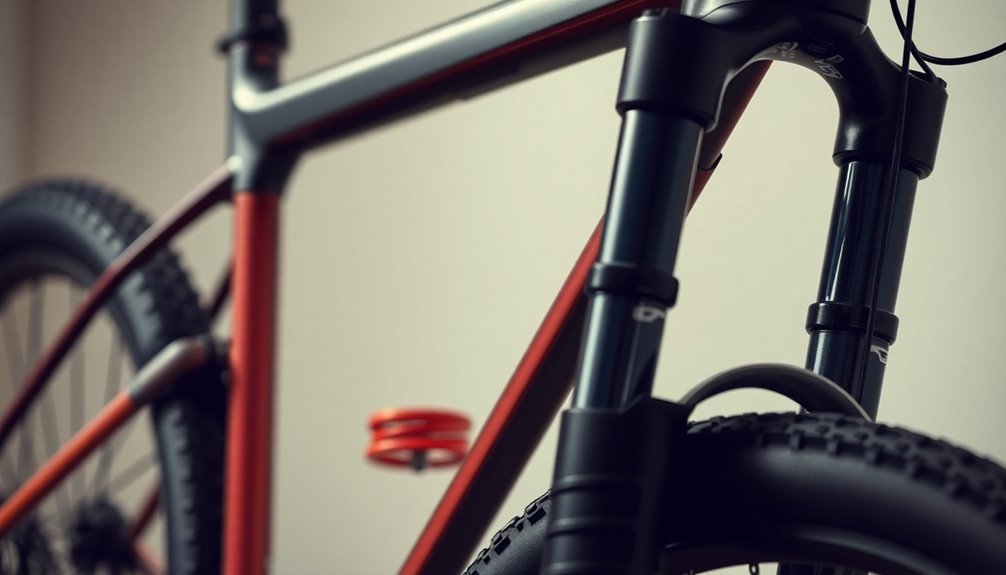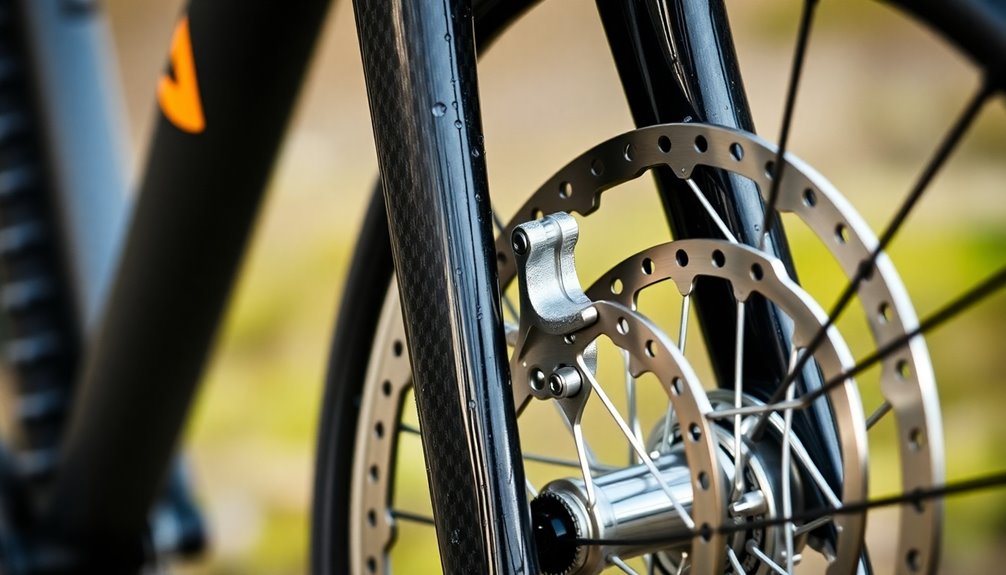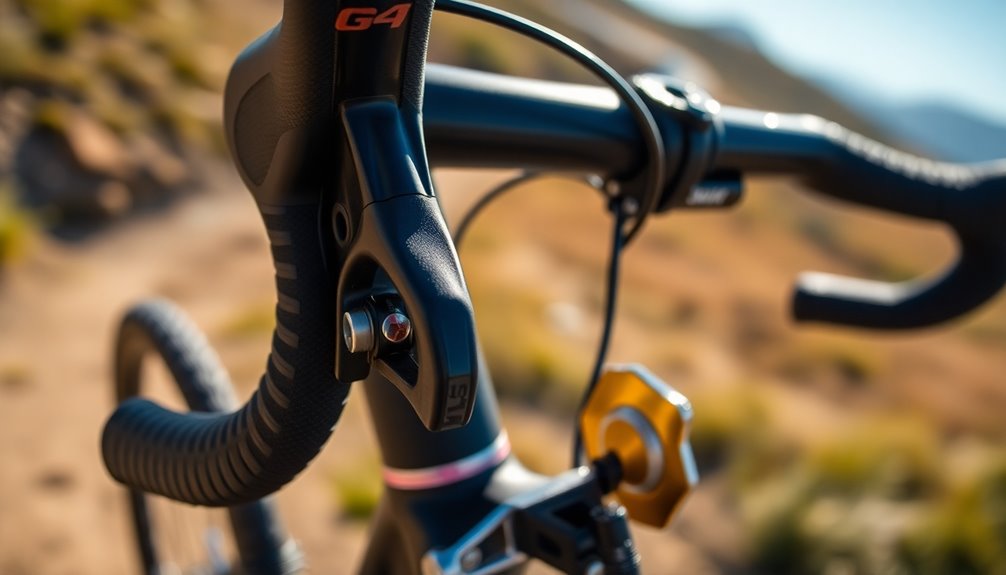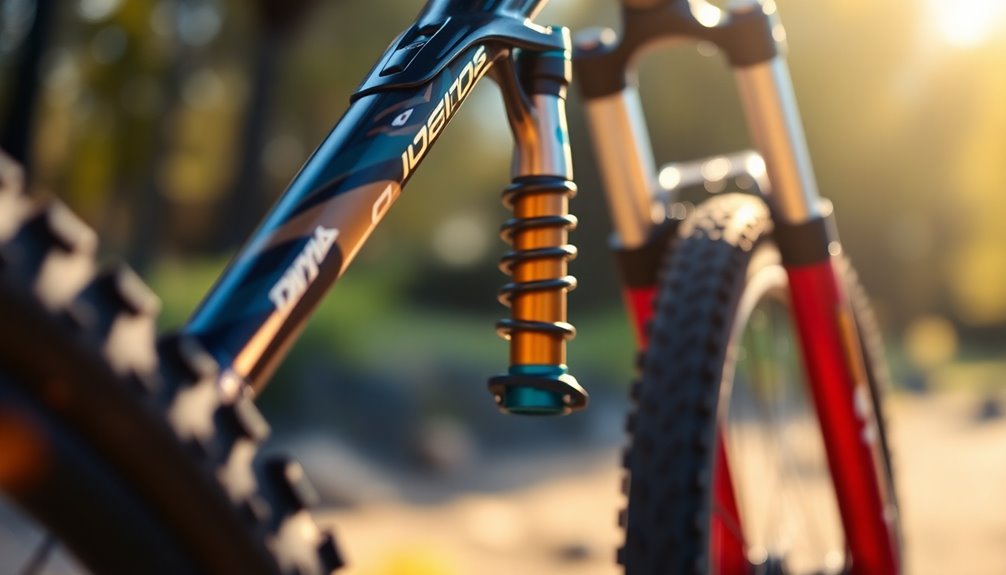Understanding your bike's components is key to improving your ride. The frame and fork shape your bike's handling, while the wheelset affects stability. Suspension systems, either hardtail or full suspension, enhance your comfort over rough terrain. Brakes, whether rim or disc, guarantee safe stops. Shifters help you change gears smoothly for peak performance. Each part plays a crucial role in your biking experience, and there's plenty more to uncover about how they all work together.
Key Takeaways
- Suspension systems enhance ride quality, with hardtail offering front suspension and full suspension providing both front and rear support for varying terrains.
- Brake systems include rim and disc brakes, with disc brakes offering superior stopping power, especially in wet conditions.
- Shifters enable smooth gear changes, available in mechanical or electronic types, often integrated with brake levers for better control.
- Handlebars come in different shapes to suit various riding styles, affecting steering dynamics and control based on width and design.
- Saddle and seat post adjustments are crucial for rider comfort, with various shapes and padding levels catering to individual preferences and riding styles.
Frame and Fork

The frame and fork are the backbone of your bike, playing an essential role in its overall performance and handling.
The frame, typically shaped in a double-diamond design, can be made from materials like aluminum alloy or carbon fiber, each affecting weight and performance. The down tube, which connects from the head tube to the bottom bracket, enhances the bike's rigidity and strength.
The frame's double-diamond design, crafted from aluminum alloy or carbon fiber, significantly influences weight and performance.
The fork connects the front wheel, allowing for precise steering. If you ride mountain bikes, consider suspension forks that absorb bumps, improving ride quality. These forks use either air or coil springs, impacting responsiveness.
Choosing the right materials and design for your frame and fork is vital for a superior riding experience.
Wheelset and Components

Your bike's wheelset is essential for performance, consisting of the front and rear wheels, hubs, spokes, and rims.
Understanding the different hub types and spoke configurations can help you choose the right setup for your riding style.
Let's break down how these components work together to enhance your biking experience.
Wheelset Structure Explained
A bike's wheelset forms the essential foundation for its performance and handling. It comprises the front and rear wheels, including hubs, spokes, and rims.
Hubs are located at the center, allowing smooth rotation and connecting the spokes to the rim. Rims, made from aluminum or carbon fiber, affect ride quality and are designed for specific tire types.
Spokes vary in number and design, typically made of steel, and connect the hub to the rim. You'll also encounter different attachment systems like quick-release and thru-axle, with the latter providing better alignment and stability, especially for disc-brake setups.
- Understanding wheelset components enhances performance.
- Hubs facilitate smooth rotation.
- Rims influence ride quality.
- Spokes connect the wheel structure.
- Material choice impacts durability.
Hub and Freehub Details
Understanding the wheelset's structure naturally leads to the hub and freehub, which play an essential role in how your bike performs.
The hub is the wheel's central component, consisting of a hub shell, axle, and bearings that guarantee smooth rotation. Freehubs allow you to coast without pedaling while staying engaged with the drivetrain when you resume pedaling.
Many hubs have disc brake mounting points for enhanced braking performance. The number of spokes connected to the hub affects your wheel's strength and stability.
Regular maintenance, including lubricating bearings and checking spoke tension, is critical for peak performance. By understanding the hub and freehub, you can make informed choices for your bike's setup and care.
Spoke Configuration Variations
While the choice of spoke configuration might seem minor, it greatly impacts your bike's performance and handling. Different spoke counts, like 28, 32, or 36 spokes, offer varying strength and weight characteristics.
Radial configurations lace spokes directly from the hub to the rim, while crossed designs allow spokes to intersect, enhancing stiffness and strength.
When selecting a configuration, consider:
- Higher spoke counts for durability in mountain biking
- Material choices like stainless steel or butted spokes for weight savings
- Proper spoke tension to maintain wheel integrity
- The impact of spoke configuration on riding comfort
- How configurations affect load-bearing capacity
Each configuration plays a vital role in your bike's overall performance and stability.
Groupset Components

When you're pedaling, the crankset and bottom bracket play an essential role in converting your effort into motion.
The rear derailleur also helps by shifting the chain smoothly across the cassette, ensuring you can tackle various terrains with ease.
Understanding these components will enhance your riding experience and bike performance.
Crankset and Bottom Bracket
A well-functioning crankset and bottom bracket are essential for maximizing your bike's performance. Your crankset, consisting of crank arms and chainrings, converts your leg power into rotational force, propelling you forward.
The bottom bracket houses bearings that allow the crankset to rotate smoothly; depending on your frame, it could be a threaded or press-fit design.
Consider these features for peak performance:
- Variety of gearing options: single, double, or triple chainrings
- Average bottom bracket width differences between road and mountain bikes
- Integrated power meters for real-time performance analysis
- Lightweight designs enhancing efficiency
- Proper maintenance for longevity and performance
Rear Derailleur Functionality
The rear derailleur plays an essential role in your bike's drivetrain, enabling seamless gear shifts as you navigate various terrains.
It shifts the chain across the sprockets of the cassette mounted on your rear wheel, thanks to its parallelogram design that allows side-to-side movement. This movement facilitates smooth gear changes by guiding the chain to the appropriate sprocket based on your selected gear.
Two jockey wheels maintain chain tension, ensuring it moves freely during shifts. Typically positioned below the rear axle, the derailleur attaches to the bike frame via a derailleur hanger, designed to bend on impact, protecting both the derailleur and frame.
Rear derailleurs come in various designs, including those optimized for single-chainring setups, offering a wide range of gear ratios.
Brakes and Shifters

How do brakes and shifters work together to enhance your ride? Your bike's braking system, whether rim brakes or disc brakes, guarantees you stop safely.
Disc brakes are especially effective in wet conditions, providing superior stopping power.
Meanwhile, shifters allow you to change gears smoothly, with options like mechanical or electronic shifters. The rear derailleur plays a vital role by moving the chain across different sprockets, facilitating effortless gear changes.
Integrated brake and shift levers, also known as brifters, let you control both functions with ease.
- Understand the difference between rim and disc brakes.
- Learn how to adjust your brake levers for comfort.
- Explore the benefits of mechanical vs. electronic shifters.
- Familiarize yourself with your rear derailleur's function.
- Practice shifting gears smoothly while braking.
Suspension Systems

When it comes to tackling rough terrain, a well-designed suspension system can make all the difference.
You've got two main choices: hardtail with front suspension only or full suspension that includes both front and rear shock absorbers.
Suspension forks are essential for mountain bikes, offering vertical movement that enhances traction and stability.
The key to great bike handling lies in understanding travel, which is how much the suspension can compress, and the type of spring used, whether air or coil.
Don't overlook the importance of tuning your setup with compression adjustments and rebound adjustments to match your riding style and terrain.
Ultimately, a good suspension system greatly boosts rider comfort, allowing you to tackle any trail with confidence.
Finishing Kit Parts

Understanding your bike's finishing kit parts is essential for enhancing comfort and control during your rides. The finishing kit includes critical components like handlebars, stem, seat post, saddle, and grips, each playing a role in rider comfort and performance.
- Handlebars: Choose shapes that suit your riding style, affecting steering dynamics.
- Stem: Adjusts handlebar height and reach for ideal comfort.
- Seat Post: Allows height adjustment for the saddle, matching your preferred riding position.
- Saddle: Available in various shapes and widths to fit different riding styles.
- Grips: Provide a non-slip surface for better control and comfort.
Frequently Asked Questions
How to Learn About Bike Parts?
To learn about bike parts, start by exploring online resources and tutorials that offer diagrams and explanations.
You can visit local bike shops to talk with knowledgeable staff who'll provide hands-on insights.
Participating in cycling workshops will also help you gain practical experience.
Don't forget to check out bike maintenance books for step-by-step guides.
Joining cycling forums can connect you with experienced cyclists who'll share valuable tips and knowledge about bike components.
What Does the 1/2/3 Mean on a Bike?
When you see 1, 2, or 3 on a bike, it's like a menu for gears.
These numbers indicate the chainring setup: a single ring (1x) keeps it simple and lightweight, perfect for mountain biking; two rings (2x) strike a balance for road and touring bikes; and three rings (3x) offer the widest range, great for tackling steep hills.
Your choice shapes your riding experience, so pick what suits your style best!
What Do the 7 Gears on a Bike Mean?
The 7 gears on your bike give you the ability to tackle various terrains and speeds.
With a single chainring in front and a cassette of seven sprockets in the rear, shifting becomes easier and requires less maintenance.
Lower gears help you climb hills effortlessly, while higher gears let you speed along flat surfaces.
What Are the Components of Bicycle Brakes?
Bicycle brakes consist of several key components that guarantee your stopping power is effective.
You'll find brake pads, which create friction against the rim or rotor, and the brake lever on your handlebars, which you pull to engage the brakes.
In disc brake systems, a rotor and caliper work together to provide better performance, especially in wet conditions.
Regular maintenance and inspection of these parts are essential for your safety and riding experience.
Conclusion
Now that you've unraveled the mysteries of your bike's components, you're practically a cycling wizard! Imagine gliding over the trails, your bike transforming into a majestic steed, effortlessly maneuvering over bumps with its suspension and stopping on a dime with those powerful brakes. Each part works in harmony, making you feel like you're flying through the air at lightning speed. So, gear up and embrace the thrill—your bike's waiting to take you on an adventure of epic proportions!









